
How often should we attend class?
Throughout the water adjustment phase and initial submersion stages we have observed babies attending class (or practicing at home) at least 4 times per week are able to learn most smoothly and naturally. This is a necessity for children who are cautious, averse to water on their face or who have been traumatized by an aggressive infant aquatic survival swim program.
When will they really learn how to swim?
Several years ago at the National Aquatic Summit in Washington, D.C., we debated for hours on the true definition of swimming. Many people who call us will ask if their babies are going to learn to swim the crawl stroke– to them, that is swimming. In infant-toddler terms, swimming to us it is the ability to move through the water, harmoniously on their own accord. Initially, for very short distances. In the younger stages, the primary mode of propulsion is kicking. For those families who continue to practice, their child will eventually be able jump in, turn around and swim back to the side. Refer to the “What Babies Can Learn” page for complete details.
Some babies who started prior to their first birthday by the age of 25 months can swim comfortably holding their breath over 20 seconds covering long distances. They come up after the swim relaxed and calm (please do not try this at home). This took hundreds of hours of practice and very gradual lengthening of the swims. Babies should finish each swim happy, not panting and not take in any water.
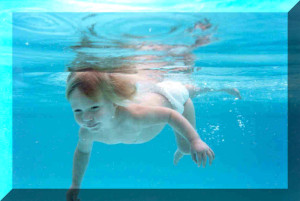
“Hi, my name is Hannah. I feel weightless and free in the water. This is my second year as a Diaper Dolphin.”
Will my child be drownproofed after taking swim lessons?
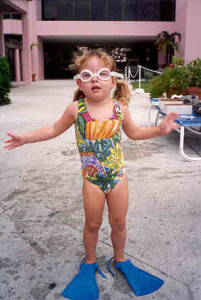 No one is ever drownproof. Utmost caution must always be in effect in and around water. Adult supervision and barriers between your child and the pool are your best defense for reducing the risk against an aquatic accident. This is discussed in depth on the home pool safety page. However, as your child reaches new levels in their swimming skills, they will eventually be able to perform maneuvers which can increase their chances of getting to safety if an unsupervised water entry were to occur. These achievements should never give parents or caregivers a false sense of security. Swim programs must make it their top priority to educate parents on all aspects of water safety. (i.e.. supervision, barriers, pool safety fencing, CPR and child centered swimming lessons). It is paramount that the well being of the baby is never sacrificed to impose the accelerated and premature acquisition of these safety skills!
No one is ever drownproof. Utmost caution must always be in effect in and around water. Adult supervision and barriers between your child and the pool are your best defense for reducing the risk against an aquatic accident. This is discussed in depth on the home pool safety page. However, as your child reaches new levels in their swimming skills, they will eventually be able to perform maneuvers which can increase their chances of getting to safety if an unsupervised water entry were to occur. These achievements should never give parents or caregivers a false sense of security. Swim programs must make it their top priority to educate parents on all aspects of water safety. (i.e.. supervision, barriers, pool safety fencing, CPR and child centered swimming lessons). It is paramount that the well being of the baby is never sacrificed to impose the accelerated and premature acquisition of these safety skills!
What safety skills are you referring to?
The following safety skills are all potentially life saving for an experienced student who is comfortable in the water and who has had adequate training with pre-requisites. These skills should only be taught when they are age appropriate and the children have the necessary foundation to begin to learn them. Refer to the “What Babies Can Learn” page for further details. Infants and toddlers must be comfortable and ready. These technical maneuvers should never be prematurely and inappropriately introduced through the use of force. Doing so can have a disastrous effect on the well-being of the child.
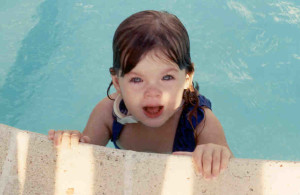 The first safety skill teaches a baby to jump in the water-turn around and swim back to the side. This is the most practical method of self rescue for infants and toddlers as the majority of accidents occur near the edge of pool or other bodies of water. Children need to be comfortable in the water and strong swimmers before this skill is introduced. Building a foundation is very important so children are not stressed in the learning process or panic during an accident.
The first safety skill teaches a baby to jump in the water-turn around and swim back to the side. This is the most practical method of self rescue for infants and toddlers as the majority of accidents occur near the edge of pool or other bodies of water. Children need to be comfortable in the water and strong swimmers before this skill is introduced. Building a foundation is very important so children are not stressed in the learning process or panic during an accident.
Recovering one’s head above the surface allows a toddler to take a bite of air. However, teaching this skill to a child too soon, creates a vertical body position, impeding progress through the water.
Rolling over to one’s back allows the toddler to breathe. All of these skills are potentially life saving. However, the back float and roll can be the most intimidating of all safety skills (when taught prematurely and inappropriately). Once children learn to sit up, most babies will begin to accept floating on their backs less and less. A handful of infants and toddlers tolerate this position. But, the majority are distressed by the process used to teach the back float. Unfortunately, through the use of force, babies can unwillingly be taught to float on their backs. One former back float instructor confided “Oh, they can float on their backs alright, but you wouldn’t want to see how I teach them to do it”. If the children are comfortable and happy with the process that is fine. Introductory adjustment activities can be taught in a playful, non-stressful way. We have observed however, that the majority of infant/toddlers are more willing to try unimposed back floating somewhere between three and four years old. Teaching from a reactive perspective, using aggressive or imposing techniques, can sadly lead to the point of breaking the child’s spirit. Nor is it reasonable to hold babies accountable for their own safety. Fortunately, many proactive strategies do exist for instructing swimming skills and implementing water safety. Combining the mastery of these safety skills at the child’s natural pace, with a comprehensive drowning prevention plan, can help to minimize the potential of an accident from occurring. Teach swimming safety skills with a long range outlook, introducing new skills only when our young students become prepared and able. Prepared not only physically, but mentally, emotionally and socially.
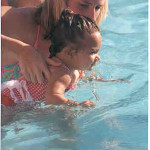
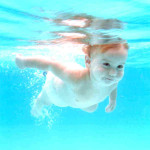
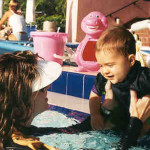
My infant learned to swim in an aggressive program, he cried but he can now swim and today enjoys the water, so what’s wrong with this?
Crying (or worse) is not a prerequisite to learning how to swim. Many children learn to eventually love the water despite their negative lesson experience. Not all children emerge from such an experience unscathed. Even if they do eventually like the water, none of the aggression was necessary in the first place. Lessons should be geared to the level and readiness of the learner. All humans, especially infants and toddlers should be treated with honor and dignity.
If your child was treated in an aggressive manner physically, emotionally or mentally in swimming lessons or for that matter in any activity I would not recommend it.
Also, a condition called hyponatremia or water intoxication is a concern to some doctors, as it can be a health risk. This is caused by swallowing excessive amounts of water. Such symptoms as disorientation and listlessness can occur. In extreme cases shock. This could occur if a young baby is pushed too hard, too soon and too long. However, there are many gentle, child-paced programs that do have your “whole child’s” interests at heart. In these programs your baby should swallow no water (or very, very little), because skills are gradually introduced when the child is ready, relaxed and happy. I have never heard of this condition occurring in a gentle program. A few babies do like to drink the water. Parents need to remember when holding their child to keep the child’s mouth above the surface. If a child’s stomach does become distended with excess water you will want to stop the lesson for the day. When practicing at home remember not to over extend your baby by showing off for the neighbors or relatives, especially if your child is just beginning to achieve proper breath control.
My pediatrician says I should wait to start until my baby is 4 years old?
The American Academy of Pediatrics states that children are not developmentally ready to learn to swim until they are 4 years old. I would agree that this is true in terms of learning the formal strokes: the crawl stroke, backstroke, butterfly and breaststroke. However, experience in thousands of child-centered programs around the world, bares witness to the fact the infants and toddlers can “swim”. See the What They Can Learn Page. What Babies Can Learn. Some people who are unaware, think that you must swim freestyle to be swimming. If you ask most experienced “baby friendly” swimming teachers, they will tell you that swimming is “harmonious movement through the water”.
The AAP is also concerned about water intoxication, which can be an issue when babies are taught with forced, premature, repeated submersions; forced back floating or where children are crying or gagging. Seek out programs which teach a gentle, gradual child-paced curriculum, following safe teaching guidelines.
Their biggest concern is that parents will become complacent once their children can perform safety skills. Children are naturally attracted to the water. Not knowing how to swim, has never stopped a child from drowning. The complacency argument could be applied to any safety measure. i.e. This infers that if a parent has taught his child not to go in the street, that they will no longer watch their child in the yard. Responsible, well informed parents will take all necessary precautions to ensure the safety of their children, especially where water is concerned.(ie. supervision, barriers, pool safety fencing, infant-child CPR and “child-centered” swimming lessons).
Do all infants and toddlers love to swim?
 I wish they did. Unfortunately, some babies are very cautious about everything. Some are frightened of new situations or strangers. Others are extremely uncomfortable with water on their face. Often, this child’s parent is also adverse to water on their face. Parents need to be relaxed, transferring a calmness to their baby. Positive, proactive parenting, consistent practice and very gradual introduction to water on the face (above the surface) all combine for success. A frightened infant or toddler can be creatively redirected to comfort through playing games, singing songs and appealing to their vivid imagination. A positive group class situation greatly helps to ease the fears of most children. Focus on what your child can do and be patient. Eventually, through a trusting and secure learning environment, play and perseverance, a tolerance for water on the face will be developed. Do not submerge children until they are relaxed and adjusted to water poured on their face. This can take time, but it’s worth the effort. Your child will appreciate it.
I wish they did. Unfortunately, some babies are very cautious about everything. Some are frightened of new situations or strangers. Others are extremely uncomfortable with water on their face. Often, this child’s parent is also adverse to water on their face. Parents need to be relaxed, transferring a calmness to their baby. Positive, proactive parenting, consistent practice and very gradual introduction to water on the face (above the surface) all combine for success. A frightened infant or toddler can be creatively redirected to comfort through playing games, singing songs and appealing to their vivid imagination. A positive group class situation greatly helps to ease the fears of most children. Focus on what your child can do and be patient. Eventually, through a trusting and secure learning environment, play and perseverance, a tolerance for water on the face will be developed. Do not submerge children until they are relaxed and adjusted to water poured on their face. This can take time, but it’s worth the effort. Your child will appreciate it.
What is the best age to start?
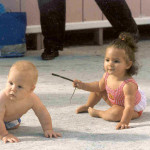 We have observed that the optimal age to start babies is between six months and 12 months old. At this stage the majority of infants are ripe in the water. They are comfortable, the water feels natural. These very young babies still seem to have a memory of the fluid environment in the womb. However, a window of opportunity for smooth learning still exits up to approximately 18 months old (especially for water adjustment and initial submersions). At approximately 19 months to 24 months toddlers can begin to enter the “challenging twos” phase. It is easier to teach water adjustment and breath control before this stage begins. However, it is never too late when utilizing a creative and interactive curriculum. The group class structure works miracles and motivates children to participate with their peers, at any age.
We have observed that the optimal age to start babies is between six months and 12 months old. At this stage the majority of infants are ripe in the water. They are comfortable, the water feels natural. These very young babies still seem to have a memory of the fluid environment in the womb. However, a window of opportunity for smooth learning still exits up to approximately 18 months old (especially for water adjustment and initial submersions). At approximately 19 months to 24 months toddlers can begin to enter the “challenging twos” phase. It is easier to teach water adjustment and breath control before this stage begins. However, it is never too late when utilizing a creative and interactive curriculum. The group class structure works miracles and motivates children to participate with their peers, at any age.
What do you think about floatation devices?
Being baby swimming advocates, we of course encourage our little ones to learn to swim primarily without floatation devices in our Lifestyle Swim School classes here in Boca Raton. Children must be aware that without floatation devices they have to know how to propel themselves safely through the water. However, “floaties” are very good in terms of supplemental training for toddlers. The majority of families from around the US and Europe who visited the Boca Resort and Club when we were headquartered there had their children in “floaties.” The vertical body position inherent in “floatie” swimming can be easily shifted to a more horizontal position in the water, once the children begin formal instruction. We found these children very easy to teach once they entered swim lessons because they were comfortable in the water, especially with water on their face. Water Wings and Bema flippers used as a training device encourage children as young as 1 1/2 years old to kick, as they chase their favorite toy or mom and dad.
Most importantly, lessons should always be fun, crying is not a prerequisite to learning how to swim.
If we take a break over the winter, will they forget everything?
No. However, a baby’s swimming abilities can become “rusty” if you are unable to refresh their skills several times a week. What we have observed is that for each month your child is not in the pool, it takes approximately 1 to 2 days to return to their previous level. For example, if you take a 5 month break from swimming, when you first return to the water it may appear that your child is starting from scratch. However, somewhere between the 5th and 10th lesson, you will be amazed at how their swimming abilities begin to return (as long as their lesson experience the previous year was a positive one). Cautious children or those returning from aggressive teaching methods can take much longer. Don’t be surprised if children who endured forceful lessons the previous year will not even go near the water. Patience, a supportive atmosphere and a positive attitude on the part of the parent allows the returning student to regain their skills more rapidly.
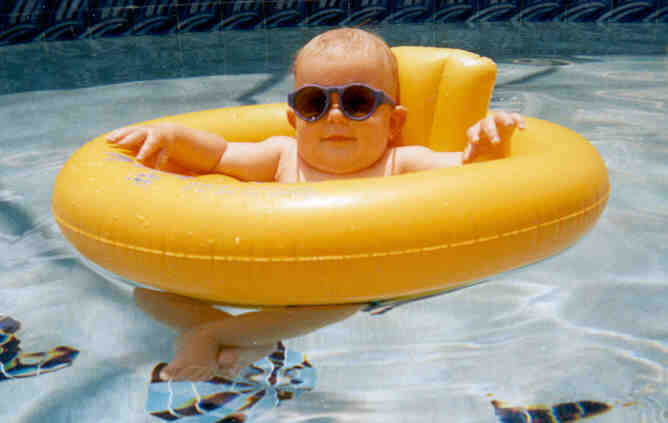

 Learning is far more effective when taught "a little bit on a lot of days", than cramming one day a week. Parents who are only able to attend class once or twice a week, need to exercise a hearty dose of patience, and supplement on non-class days with practice at home, even if just for ten minutes. If you do not have access to a pool for practice, enjoyable baths are very beneficial for water adjustment on the face. Gently pour small amounts of water down your child's face, on the count 1-2-3-pour on four. Do this several times a bath (before you add soap or shampoo). You can employ puppets, washcloths, nerf balls and dolls to assist with this activity.
Once your baby is kicking through the water holding their breath for 5 seconds (this takes time), if you need to cut back on practice days, just be aware that your child's swimming progress is roughly linked to how often you practice. Enjoy each class for it’s own sake.
Learning is far more effective when taught "a little bit on a lot of days", than cramming one day a week. Parents who are only able to attend class once or twice a week, need to exercise a hearty dose of patience, and supplement on non-class days with practice at home, even if just for ten minutes. If you do not have access to a pool for practice, enjoyable baths are very beneficial for water adjustment on the face. Gently pour small amounts of water down your child's face, on the count 1-2-3-pour on four. Do this several times a bath (before you add soap or shampoo). You can employ puppets, washcloths, nerf balls and dolls to assist with this activity.
Once your baby is kicking through the water holding their breath for 5 seconds (this takes time), if you need to cut back on practice days, just be aware that your child's swimming progress is roughly linked to how often you practice. Enjoy each class for it’s own sake.